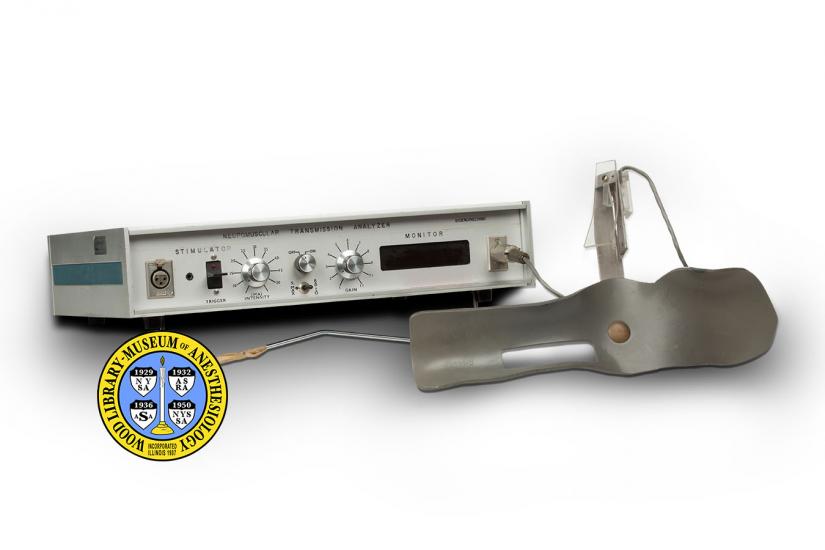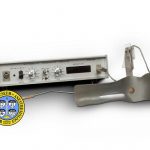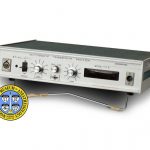Ali’s “Train-of-Four”
For general anesthesia, muscle relaxants are used to keep the entire body still during surgery. Before, during and after surgery, the level of relaxation is tested using a peripheral nerve stimulator (PNS). These stimulate a motor nerve with a mild electrical current, usually delivered through disposable electrodes, causing the related muscles to contract. The degree of this response is the most accurate guide to the extent of relaxation, called neuromuscular blockade.
Some PNS devices require the anesthesiologist to judge the patient’s response by clinical observation. A more objective method is the “train-of-four” monitor (TOF). This concept was developed by Dr. Hassan H. Ali and his associates at Harvard University. The prototype of Dr. Ali’s Neuromuscular Transmission Analyzer, shown here, was built in 1972. The arm-board holds the patient’s hand so that the thumb is aligned with a transducer that senses the patient’s response to a rapid series of four electrical stimuli. The degree of muscle response is automatically calculated, and displayed on a screen. Today, TOF devices are used both in operating rooms and intensive care units.
Catalog Record: Ali’s “Train-of-Fourâ€
Access Key: akwm
Accession No.: 2008-05-12-1 A-C
Title: [Neuromuscular transmission analyzer.]
Author: Ali, Hassan H.
Author: Cywinski, Jozef K.
Author: Cintron, Rafael.
Author: Newbower, Ronald S.
Title variation: Alt Title
Title: Ali “Train of Four”.
Title variation: Alt Title
Title: Neuromuscular transmission analyzer prototype.
Publisher: [Boston] : Harvard Anesthesia Center Bioengineering Laboratories, [1972].
Physical Descript: 1 monitoring device ; metals, plastics : 10 x 43.5 x 35 cm + attachments
Subject: Peripheral Nerve Stimulator.
Subject: Intraoperative Neurophysiological Monitoring – instrumentaiton.
Subject: Neuromuscular Monitoring – instrumentation.
Subject: Monitoring, Physiologic – instrumentation.
Subject: Neuromuscular Blocking Agents – history.
Subject: Electric Stimulation – instrumentation.
Note Type: General
Notes: The date for the possible year of manufacture is based on an email to the WLM
from Dr. Ali in which he describes the device and reports this year (1972) as
the year of creation. 1972 is also the year that the inventors described this
device at the 1972 American Society of Anesthesiologists Annual Meeting.
Note Type: General
Notes: The title is based on the name used by Dr. Ali, Dr. Cywinski, Mr. Cintrol and
Dr. Newbower in the abstract that accompanied their presentation at the 1972
American Society of Anesthesiologists Annual Meeting. The title is also based
on the name used by Dr. Ali and Dr. Kitz when describing the device in a 1973
article published in Anesthesia and Analgesia.
Note Type: Citation
Notes: Ali HH. Criteria of adequate clinical recovery from neuromuscular block.
Anesthesiology. 2003;98(5):1278-1280. https://journals.lww.
com/anesthesiology/toc/2003/05000. Accessed October 28, 2014.
Note Type: Citation
Notes: Ali HH, Cywinski JK, Cintrol R, Newbower RS. Digital neuromuscular
transmission analyzer: a clinical evaluation. In: Abstracts of Scientific
Papers: 1972 ASA Annual Meeting. United States of America: American Society
of Anesthesiologists, Inc.; 1972:219-220.
Note Type: Citation
Notes: Ali HH, Kitz RJ. Evaluation of recovery from nondepolarizing neuromuscular
block, using a digital neuromuscular transmission analyzer: preliminary
report. Anesth Analg. 1973;52(5):740-744. https://journals.lww.
com/anesthesia-analgesia/toc/1973/09000. Accessed October 28, 2014.
Note Type: Citation
Notes: Ali HH. A new device for monitoring force of thumb adduction. Brit J Anesth.
1970;42(1):83-85.
Note Type: Citation
Notes: Ali HH, Utting JE, Gray TC. Quantitative assessment of residual
antidepolarizing block (part I). Brit J Anaesth. 1971;43(2):473-476.
Note Type: Citation
Notes: Ali HH, Utting JE, Gray C. Stimulus frequency in the detection of
neuromuscular block in humans. Brit J Anaesth. 1970;42(11):967-977.
Note Type: Citation
Notes: Email from Ali, Hassan H., MD. September 14, 2006. Accession documentation:
2006-9-15-1. Located at: The Wood Library-Museum of Anesthesiology,
Schaumburg, Illinois.
Note Type: Citation
Notes: Norman J. Commentary: Ali HH, Utting JE, Gray C. Stimulus frequency in the
detection of neuromuscular block in humans. British Journal of Anaesthesia
1970;42:967-978. Brit J Anaesth. 1998;80:528-529.
Note Type: Physical Description
Notes: One device to stimulate the ulnar nerve and measure the neuromuscular
response; The physical measurements provided are for the main body of the
device; The bluish paint or coating on the top and sides of the device is
dusty and soiled with numerous scratches; On the face of the device, from
theft to right, are the following features: A port or inlet for a
three-pronged plug, a stimulator trigger, and a stimulator intensity control
dial with 10 increments from 0 to 50, an on/off turn switch, a mode toggle
switch, a dial for controlling gain, a monitor screen, and a four pronged
port or inlet; The 0 or first increment of the intensity control dial is not
numbered; The remainder of the increments of the intensity control dial are
numbered 10, 15, 20, 25, 30, 35, 40, 45, 50; The mode toggle switch is
labeled “S. MAX” on the left and “RATIO” on the right; The dial for the gain
has 11 increments numbered from 1 to 11; Just below the monitor screen is a
handmade label with the following text, “HASSAN H. ALI MD”; On each side of
the device is a sticker with the following markings, “HARVARD ANESTHESIA
CENTER [new line] BIOENGINEERING [new line] LABORATORIES [new line]
MASSACHUSETTS GENERAL HOSPITAL”; A long grey cord, with a Hubbell locking
plug, exits the back of the device; The cord feels tacky; A small protrusion
on the back of the device is labeled “FUSE”; The stimulator cord with the
three pronged plug is approximately 315 cm in length; It ends in two wires,
one of which ends in a red colored electrical contact and the other in a
black colored electrical contact; An arm-board with a “thumb force
transducer” is attached to a long cord with a plug end that matches the four
pronged port that is located just to the right of the digital display screen;
The arm-board’s is made of a molded plastic; The following is scratched into
the armrest, “DR. ALI ANESTH.”; The thumb-rest and ‘force transducer’ consist
of metals, plastics and wires; The cord and plug are approximately 310 cm in
length; From fingertip to wrist area, the arm board is approximately 40 cm in
length and 25 cm in width (thumb-rest included; The arm-board with thumb-rest
measure approximately 8 cm in depth.
Note Type: Reproduction
Notes: Photographed by Mr. Steve Donisch, September 17, 2013.
Note Type: Historical
Notes: From 1968 to 1970, during a research fellowship at the University of
Liverpool in England, anesthesiologist Dr. Hassan H. Ali studied muscle
responses to various mild electrical stimuli. He was hoping to find a better
method for assessing patients who were given muscle relaxants for surgery.
With British anaesthetists J.E. Utting and T. Cecil Gray, he developed an
important assessment technique generally referred to as “train-of-four
monitoring.” Introduced in 1970, it involves delivering successive electrical
stimuli to a peripheral nerve and noting the response to each stimuli. Each
response, or lack thereof, can provide the anesthesiologist with a sensitive
measurement of the degree of a patient’s muscle relaxation.
In order to objectively measure the responses during these studies, Dr. Ali
designed a sensor in the form of a hand grip. The device was satisfactory for
the research phase, but in 1972, after returning to the U.S., he worked with
biomedical engineers in the anesthesia department at Harvard Medical School
and Massachusetts General Hospital to develop a new one. It contained all of
the functions needed to deliver the electrical stimuli to the ulnar nerve
near the wrist, measure the muscular response (or twitch) of the thumb,
digitally display the results and calculate the ratio of the fourth twitch to
the first.
Techniques for assessing the effect of muscle relaxants prior to the
introduction of the train-of-four (TOF) method were less sensitive and could
be uncomfortable for the patient. TOF is still in use today, sometimes the
response is measured by visual and tactile observation and sometimes with
technology in the vein of Dr. Ali’s Neuromuscular Transmission Analyzer.
For more information about monitoring and muscle relaxants see the catalog
records for the Block-Aid Monitor and Curare.
Note Type: Exhibition
Notes: Selected for the WLM website.



